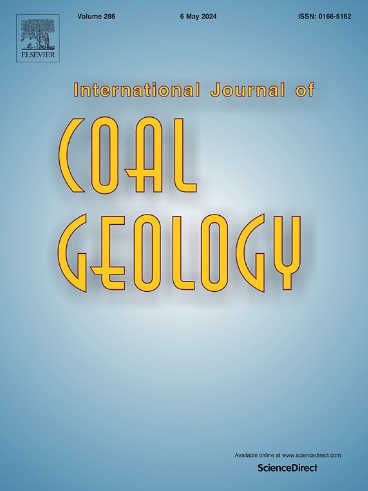瑞典上寒武统kolm地球化学及有机岩石学特征:成因意义
IF 5.6
2区 工程技术
Q2 ENERGY & FUELS
引用次数: 0
摘要
Kolm指的是在瑞典中南部明矾页岩组的Furongian部分的含铀透镜体(1280-7100 ppm)和富有机物透镜体(25-71 wt%)。它通常小于7厘米厚,形成薄而不连续的层。通过地球化学和有机岩石学研究,认为其有机质可能为次生形成的固体沥青,而非原生富有机质组分。高铀含量集中在特定的富铀钇锌(U-Y-Zn-rich)颗粒中。提出了一个矿石形成的模型,表明在沉积过程中,最初的富铀颗粒形成,然后浓缩,可能是在缺氧条件下在海底进行的筛分。这种富含铀粒子的滞后矿床随后为早期成岩作用中生长的钴矿结核形成了放射性核(富u - y - zn粒子)。初始石灰显然是由成岩形成的固体沥青(Ro <;0.5%)落在这些强放射性的富铀锌粒子上。与瑞典中南部其他地区相比,Västergötland Billingen地区的kolm发育更为丰富,这可能是由于二叠-石炭系侵入的局部加热导致固体沥青的生成增加。本文章由计算机程序翻译,如有差异,请以英文原文为准。
The geochemical and organic petrological characteristics of kolm (upper Cambrian, Sweden): Implications for genesis
Kolm refers to uraniferous (1280–7100 ppm) and organic-rich (25–71 wt%) lenses occurring exclusively within the Furongian part of the Alum Shale Formation in south-central Sweden. It typically less than 7 cm thick and forms thin discontinuous layers. This study investigates the geochemical and organic petrological characteristics of kolm, and it is shown that the organic matter likely represents secondarily formed solid bitumen rather than a primary organic-rich component. The high uranium content is concentrated in specific uranium‑yttrium‑zinc-rich (U-Y-Zn-rich) particles. A model for kolm formation is presented, suggesting that during sedimentation, initial uranium-enriched particles were formed and then became concentrated, probably by winnowing at the sea floor under euxinic conditions. This lag deposit rich in uranium particle subsequently formed the radioactive nuclei (U-Y-Zn-rich particles) for the kolm nodules that grew during the early diagenesis. Initial kolm was apparently formed by in-situ accumulation of diagenetically formed solid bitumen (Ro < 0.5 %) onto these strongly radioactive U-Y-Zn-rich particles. The more abundant development of kolm in the Billingen area of Västergötland, compared to other regions in south-central Sweden where kolm occurs, is likely due to increased generation of solid bitumen associated with localized heating from Permo-Carboniferous intrusions.
求助全文
通过发布文献求助,成功后即可免费获取论文全文。
去求助
来源期刊

International Journal of Coal Geology
工程技术-地球科学综合
CiteScore
11.00
自引率
14.30%
发文量
145
审稿时长
38 days
期刊介绍:
The International Journal of Coal Geology deals with fundamental and applied aspects of the geology and petrology of coal, oil/gas source rocks and shale gas resources. The journal aims to advance the exploration, exploitation and utilization of these resources, and to stimulate environmental awareness as well as advancement of engineering for effective resource management.
 求助内容:
求助内容: 应助结果提醒方式:
应助结果提醒方式:


